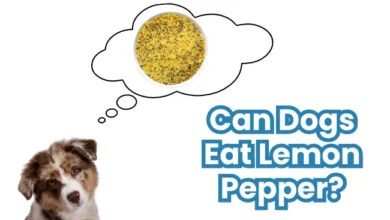
If you’re a dog parent, you know that our furry friends love to share in our snacks, whether it’s a bite of our sandwich or a few crumbs from our fries. But when it comes to certain treats, it’s important to know what’s safe for them and what isn’t. For example, you might wonder, “Can dogs eat licorice?” While licorice might seem like an innocent snack, it can actually pose serious risks to your dog’s health.
Understanding what foods are safe and which ones should be kept away from your pup can help prevent accidents and keep them happy and healthy. You might also ask, “Can dogs eat French fries?” While that’s another common snack that might seem harmless, it too comes with its own set of concerns. Let’s dive in and explore whether licorice is safe for dogs, so you can keep your four-legged friend safe and sound.
Can Dogs Eat Licorice?
No, dogs should not eat licorice, whether it’s black or red, or licorice root.
Explanation:
Licorice contains glycyrrhizin, a compound that can be toxic to dogs in large amounts. While it can have health benefits for humans, it can cause serious issues for dogs, including high blood pressure, water retention, and other dangerous health conditions. Black licorice candy also contains ingredients like sugar, high-fructose corn syrup, and wheat gluten, which can upset your dog’s digestive system, lead to weight gain, and cause other health problems. Instead of licorice, opt for healthy, dog-friendly treats like fruits and veggies to keep your pup happy and safe.
What Is Licorice and Why Are Dogs Interested in It?
Licorice is a sweet treat made from the root of the licorice plant. It’s often found in candies, gummies, and other flavored snacks that we enjoy. The plant’s root is used for its natural sweetness and medicinal properties in humans. For dogs, however, licorice is a no-go for their health.
So, why are dogs so interested in it? Like many human foods, licorice has a strong, sweet aroma and flavor that can catch a dog’s attention. Dogs are naturally drawn to sweet scents and flavors, especially when they’re used to getting little treats from us. This curiosity often leads them to sniff around or try to grab a bite when they smell something tasty.
But here’s the catch: while it may be tempting for dogs to indulge, licorice can be harmful to them, as it contains a compound called glycyrrhizin, which can cause health problems. Understanding why dogs are attracted to licorice can help you be more cautious about where you store it and how you manage your dog’s diet. Keeping licorice out of reach and offering safe, dog-friendly treats will keep them safe from the potential dangers of this sweet snack.
Remember, your dog might love the smell of licorice, but it’s best to stick to treats made just for them!
The Dangers of Licorice for Dogs
While licorice may seem like a harmless treat, it can actually be dangerous for your dog. Let’s break down why this sweet snack should be kept away from your furry friend.
Glycyrrhizin
Licorice contains a compound called glycyrrhizin, which can be very harmful to dogs. When consumed in large amounts, glycyrrhizin can cause serious health issues, including high blood pressure, potassium imbalances, and even heart problems. This compound can also lead to water retention, making your dog feel bloated and uncomfortable. Even small amounts of licorice can upset your dog’s system, so it’s best to avoid it entirely.
Xylitol
Some licorice products, especially sugar-free varieties, contain xylitol—a sweetener that’s incredibly toxic to dogs. Just a small amount of xylitol can cause a rapid drop in blood sugar, leading to symptoms like vomiting, loss of coordination, and seizures. In severe cases, xylitol poisoning can even be fatal. So, if you ever think about giving your dog a licorice treat, double-check the ingredients, and avoid anything with xylitol.
Other Harmful Ingredients
Licorice candy is also packed with sugar, artificial sweeteners, and other additives that aren’t good for your dog. These ingredients can upset your dog’s stomach, cause weight gain, and even lead to diabetes if consumed regularly. Too much sugar and artificial ingredients can also harm your dog’s teeth, leading to dental problems over time.
It’s clear that licorice, with all its harmful ingredients, is not a safe treat for your dog. Instead of reaching for the licorice, consider healthier alternatives like dog-friendly fruits or veggies to give your pup a tasty, safe snack. Always remember, a little extra care in what you feed your dog goes a long way in keeping them happy and healthy!
Symptoms of Licorice Toxicity in Dogs
Licorice may seem like a harmless treat for humans, but for dogs, it can be dangerous. If your dog accidentally ingests licorice, it’s important to keep an eye out for signs of toxicity. Here’s what to watch for:
Immediate Signs
When a dog eats licorice, some common symptoms of toxicity can show up fairly quickly. These may include:
- Vomiting: If your dog throws up soon after eating licorice, it could be a sign that their stomach is reacting negatively to it.
- Diarrhea: An upset stomach might also lead to loose stools or diarrhea, as your dog’s body tries to expel the toxins.
- Lethargy: Dogs who are normally full of energy may seem unusually tired or sluggish after consuming licorice.
- Tremors: You might notice your dog shaking or having muscle tremors, which is a sign that something isn’t right in their system.
Severe Reactions
In some cases, licorice toxicity can cause more severe reactions. These may require immediate veterinary attention. Watch for:
- Seizures: If your dog starts having seizures, it’s critical to get them to a vet right away. Seizures are a serious sign that the toxins in licorice are affecting the nervous system.
- Need for Immediate Veterinary Care: If your dog shows any of these serious symptoms, don’t wait—contact your vet or an emergency animal clinic. The sooner treatment begins, the better the chances of recovery.
Remember, prevention is always better than cure. Keep licorice and other foods that are toxic to dogs out of reach, and if you suspect your dog has eaten any, don’t hesitate to get professional help. Your dog’s health and safety are always worth the extra precaution.
What to Do If Your Dog Eats Licorice
If your dog eats licorice, it’s important to stay calm and act quickly. While licorice can be harmful to dogs, the right steps can help ensure your pet stays safe.
Immediate Actions
The first thing you should do is contact a veterinarian or call a pet poison hotline. Even if your dog hasn’t shown symptoms yet, it’s always best to get professional advice right away. The sooner you take action, the better. The vet may ask you details like how much licorice your dog ate, their size, and any symptoms they’re showing.
Monitoring
After reaching out to a professional, keep an eye on your dog for any signs of distress. Symptoms like vomiting, diarrhea, lethargy, or tremors could appear within hours. If you notice any of these signs, call your vet immediately for further guidance.
Even if your dog seems fine, it’s still a good idea to monitor them closely for the next 24 hours, just to be safe. Always trust your instincts—if something doesn’t seem right, don’t hesitate to get help.
Prevention
Prevention is the key to avoiding accidental poisoning. Keep licorice and other harmful foods out of reach of your pets. Make sure candy, gum, and other snacks are stored securely where your dog can’t get to them. It’s a simple step that can save you a lot of stress later.
By staying proactive and knowing what to do, you can help keep your dog healthy and safe from the dangers of licorice and other toxic foods.
Safe Alternatives to Licorice for Dogs
While licorice may be tempting, it’s not the best treat for your dog. Thankfully, there are plenty of delicious and healthy alternatives that your furry friend will love!
Healthy Treats
Here are some great dog-safe options that are not only tasty but also good for your dog’s health:
- Carrots: Crunchy, sweet, and full of vitamins, carrots make a perfect low-calorie treat.
- Apples (without seeds): Apples are a sweet and refreshing snack. Just be sure to remove the seeds, as they can be harmful to dogs.
- Specially Formulated Dog Treats: There are many treats available that are made with your dog’s health in mind. Look for those with natural ingredients and without added sugars or artificial additives.
Homemade Options
If you like making things from scratch, why not try these simple, dog-friendly recipes? Here are a couple of ideas:
- Peanut Butter & Banana Bites:
- Mash half a banana and mix it with a spoonful of natural peanut butter (make sure it doesn’t contain xylitol, which is toxic to dogs).
- Roll into small balls and freeze them for a cool, tasty treat your dog will love!
- Sweet Potato Chews:
- Slice a sweet potato into thin rounds and bake at a low temperature until they are crispy. Sweet potatoes are full of nutrients and make a great chew that’s safe for your dog.
By offering these safe alternatives, you can satisfy your dog’s craving for treats without the worry of harmful ingredients. Your pet will love these tasty snacks, and you’ll have peace of mind knowing they’re good for them!
Conclusion
- Summary: Reiterate that licorice, in any form, is not safe for dogs due to potential health risks.
- Final Advice: Encourage pet owners to opt for safe, healthy treats and consult veterinarians for any concerns.
FAQs
Can dogs eat red licorice?
No, dogs should not eat red licorice. It contains high levels of sugar and artificial ingredients, which offer no nutritional value to your dog. Consuming it can lead to upset stomachs, weight gain, and even long-term health issues.
What if my dog ate a small piece of licorice?
If your dog ate a small piece of licorice, monitor for any symptoms like vomiting or diarrhea. If your dog shows any unusual signs or if you’re concerned, contact your vet for advice. It’s always better to be safe.
Are there any licorice-flavored treats safe for dogs?
Most licorice-flavored treats are not safe for dogs due to harmful ingredients like sugar and artificial flavorings. Always check the ingredients list and choose treats specifically made for dogs to ensure they are safe and nutritious for your pet.
Conclusion
In summary, licorice, in any form, is not safe for dogs. Whether it’s red licorice or black licorice, it contains ingredients that can cause harmful side effects, from upset stomachs to more serious health risks. It’s always better to be cautious and avoid giving licorice to your dog.
As pet owners, we want the best for our furry friends, and this means choosing safe, healthy treats that are good for them. Opt for dog-friendly snacks like carrots, apples (without seeds), or treats made specifically for dogs. Always consult your veterinarian if you have any concerns about your dog’s diet or if they’ve eaten something potentially harmful.
Your dog’s health and happiness are worth the extra care!




